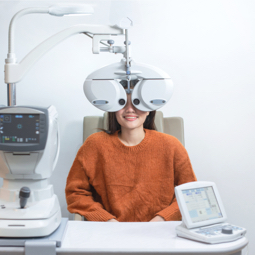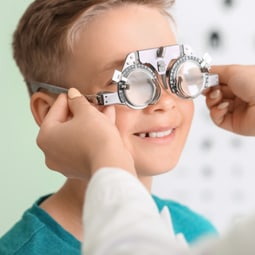Good Vision Doesn’t Mean You’re Problem-Free
Many people assume that if there are no problems with their vision, visiting the eye doctor becomes less important. Unfortunately, if an eye disease isn’t causing any noticeable symptoms, it could develop for a long time before it’s diagnosed and treated.
If you’re getting eye exams as recommended by your optometrist, there’s a better chance that your eye doctor will be able to detect problems and begin early treatment. Contact us today and book an appointment with Dr. Parks to discuss your eye health.



Eye Exams & Eye Disease Diagnosis
The American Optometric Association recommends that most adults receive an eye exam every 1 to 2 years, depending on their age. From 18 onwards, an annual exam is typically adequate. But adults over 64 and those at a higher risk for complications should get annual exams.
Other than updating your prescription and monitoring the health of your eyes, your eye doctor will also look for early stages of eye diseases during an eye exam. In some cases, this could allow for a jumpstart on treatment.

Common Eye Disease & Conditions
If there are risk factors for a particular disease or condition, the eye doctor may focus the exam on a specific part of the eye.
Cataracts
A common age-related eye condition that the eye doctor will be looking for—especially in patients over 40—is cataracts. The eye’s naturally clear lens grows cloudy over time. Most people with cataracts don’t notice any vision changes at first.
Additionally, a cataract doesn’t typically pose an immediate threat to your vision. And cataract surgery isn’t necessary until the condition affects your daily life. This surgery is the only permanent fix for a cataract.
Glaucoma
Typically, glaucoma is another age-related condition. However, an eye injury could cause glaucoma, and in rare cases, a baby can be born with it. There are several types of glaucoma, and most of them are the result of abnormal pressure in the eye. This pressure causes damage to the optic nerve, and can result in vision loss.
Age-Related Macular Degeneration (AMD)
Like other diseases, AMD can develop with little to no symptoms usually, and can lead to eventual vision loss.
The more common form of AMD is dry AMD. This form of the disease typically develops slowly over time as the macula grows thinner with age. Vision therapy or other steps to protect your vision may be necessary as there is no cure for AMD.
There is also a less common form of AMD called wet AMD. If you develop this disease, it’s an emergency situation in many cases. If you suddenly see a large amount of new floaters, have sudden eye pain, or reduced central vision, you should contact your eye doctor or go to the emergency department immediately.
Dry Eye
Dry eye disease doesn’t typically result in vision loss or permanent damage. However, it can be extremely uncomfortable. Sometimes climate is the cause, but other times it could be an underlying reason, such as a side effect from medication or a medical condition.
Don’t Wait to See Your Eye Doctor
You only have one set of eyes, and it’s important to do all you can to take care of them. Staying on top of regular visits to your eye doctor is your best defense against eye disease. If you’re due for an eye exam, we’d love to see you!
Reach out to our office today and book an appointment.
Our Google Reviews

Our Location
Convenient for You
Find us in the River Rock Village shopping center right in front of the pond.
Parking
There’s a large parking lot at our location, including several spots just outside our entrance.
Our Address
- 127 Village Drive, Suite 300
- Belgrade, MT 59714
Contact Information
- Phone: 406-388-9661
- Fax: 406-388-9662
- Email: [email protected]









